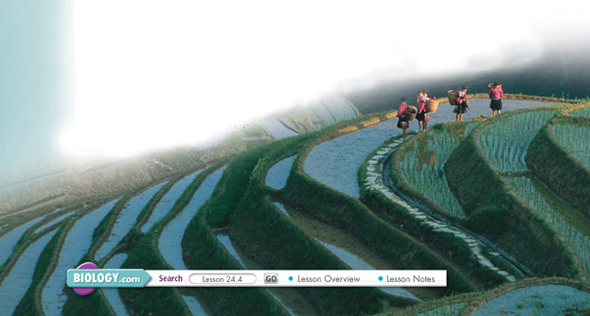24.4 Plants and Humans
 Which crops are the major food supply for humans?
Which crops are the major food supply for humans? What are some examples of benefits besides food that humans derive from plants?
What are some examples of benefits besides food that humans derive from plants?
green revolution
Preview Visuals Preview Figure 24–24. Identify what plants provided the raw materials for the products shown in the photos. Then list any other products you can think of that come from plants.
THINK ABOUT IT A stroll through the produce section of a grocery store will convince you that plants are important. Even a medium-sized food store will contain products made from hundreds of different plant species. But which ones are the most important? Are there certain plants that we simply couldn't live without?
Agriculture
 Which crops are the major food supply for humans?
Which crops are the major food supply for humans?
The importance of agriculture—the systematic cultivation of plants—should be obvious, even to those of us who live in urban areas and seldom visit a farm. Modern farming is the foundation on which human society is built. North America has some of the richest, most productive cropland in the world. As a result, farmers in the United States and Canada produce so much food that they are able to feed millions of people around the world as well as their own citizens.
Worldwide Patterns Many scholars now trace the beginnings of human civilization to the cultivation of crop plants. Evidence suggests that agriculture developed separately in many parts of the world about 10,000 to 12,000 years ago. Once people discovered how to grow plants for food, the planting and harvesting of crops tended to keep them in one place for much of the year, leading directly to the establishment of social institutions. Even today, agriculture is the principal occupation of more human beings than any other activity.
Thousands of different plants—nearly all of which are angiosperms—are raised for food in various parts of the world. Yet, despite this diversity, much of human society depends upon just a few of these plants.  Worldwide, most people depend on a few crop plants, such as rice, wheat, soybeans, and corn, for the bulk of their food supply. The same crops are also used to feed livestock.
Worldwide, most people depend on a few crop plants, such as rice, wheat, soybeans, and corn, for the bulk of their food supply. The same crops are also used to feed livestock.

FIGURE 24–21 Plants and Agriculture Rice is a staple crop in China and many nations of Southeast Asia.
Table of Contents
- Formulas and Equations
- Applying Formulas and Equations
- Mean, Median, and Mode
- Estimation
- Using Measurements in Calculations
- Effects of Measurement Errors
- Accuracy
- Precision
- Comparing Accuracy and Precision
- Significant Figures
- Calculating With Significant Figures
- Scientific Notation
- Calculating With Scientific Notation
- Dimensional Analysis
- Applying Dimensional Analysis




